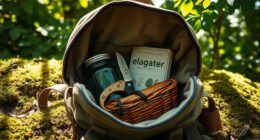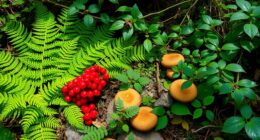To find water in the wilderness, look for dark green, lush vegetation and signs of animal activity like tracks and trails pointing downhill. Watch for dew, moist rocks, or damp ground in the early morning, and listen for insects around plants. You can collect rain, dew, or moisture from plants, or dig a pond or solar still. If you stay alert to these clues, you increase your chances of locating safe water—more techniques await you.
Key Takeaways
- Look for lush green vegetation, animal tracks, and bird activity pointing downhill or toward water sources.
- Collect morning dew with cloths or smash plants to extract moisture.
- Use natural features like rock crevices, tree crotches, or depressions to find standing water.
- Follow animal signs such as trails, urine, or fresh droppings leading to water.
- Purify any water collected by boiling, filtering, or chemical disinfection before drinking.
Recognizing Natural Water Indicators
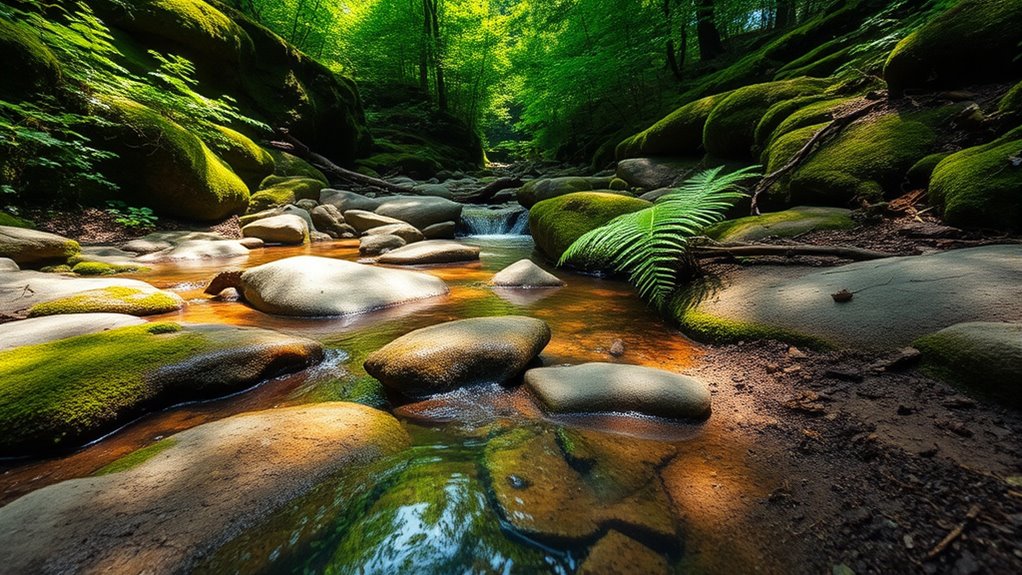
When you’re in the wilderness, look for signs that water might be nearby. Dense, darker green vegetation often indicates water sources because plants thrive with consistent moisture. During the early morning, dew on plants, rocks, and the ground is a clear sign of nearby water, as moisture condenses overnight. Pay attention to environmental conditions—cooler temperatures near water bodies can cause increased insect activity or specific plant growth patterns. The sky over water tends to appear a deeper shade of blue, especially on clear days, hinting at water’s presence below. Low-lying clouds or early morning fog over the landscape can also signal water in the area. Recognizing these natural indicators helps you locate water efficiently in the wilderness. Additionally, observing the contrast ratio of surrounding areas can sometimes reveal hidden water sources by highlighting the difference in light and shadow patterns. Being aware of water flow patterns can further improve your chances of finding a reliable water source. Monitoring vegetation types and their distribution can also provide clues to water availability and help guide your search more effectively. Understanding the topography of the terrain can assist in predicting water flow and collection points, making your search more strategic. Recognizing remote sensing techniques used in natural water detection can also give you an advantage in identifying water sources from a distance.
Tracking Animal Signs to Locate Water

Look for animal trails that form “V” shapes pointing downhill, which often lead to water sources. Keep in mind that animal waste is usually found near water, so staying several hundred yards away can give you cleaner options. Also, observe bird flight patterns and insect activity, as these signs frequently signal nearby water.
Animal Trail Patterns
Animal trail patterns can be valuable clues in locating water, especially in wilderness areas. By observing trail patterns, you can identify where animals frequently visit water sources. V-shaped trails that point downhill often lead directly to water, as animals follow the natural flow. Converging animal tracks or urine trails in vegetation suggest a nearby water source. Bird flight paths, especially low or straight-line flights toward specific areas, can also indicate water presence. Additionally, insect activity, like bees or ants following trails or entering holes, can help you detect water nearby. Recognizing these signs improves water detection, saving you time and effort. Keep an eye out for:
- Animal trails forming “V” shapes
- Converging tracks downhill
- Urine trails near vegetation
- Bird flight paths toward water
- Understanding animal behaviors can enhance your ability to interpret signs and find water more effectively in the wild.
- Observing animal movement patterns can further improve your chances of locating water sources efficiently.
- Being aware of water-seeking behaviors in wildlife can help you interpret trail signs more accurately.
Animal Waste Clues
Tracking animal waste is a practical way to locate nearby water sources, since many animals tend to urinate and defecate close to where they drink. Fresh animal waste, especially if found in clusters, can point you toward water. Remember to look for animal tracks that lead in a “V” shape; the point of the “V” often indicates the direction to water. Wildlife clues like insects—bees, ants, and flies—gathering around holes or plants suggest underground or surface water nearby. If animals are drinking during dawn or dusk, it’s a strong sign of nearby water sources. Moving several hundred yards away from animal trails or waste sites can help you find cleaner water. Monitoring animal behavior can provide additional insights into the presence of water sources nearby. Recognizing animal activity patterns can also guide you more effectively toward water sources. Additionally, observing natural water indicators like lush vegetation or moss growing on rocks can further confirm the proximity of water sources. A diverse range of signs increases your chances of locating safe water in the wilderness. Being attentive to environmental cues can help you interpret subtle signals that point to water availability.
Collecting Rain, Dew, and Vegetation Moisture

Collecting moisture from rain, dew, and vegetation is an essential skill for surviving in the wilderness. To gather rainwater, set up tarps, plastic sheets, or ponchos to funnel water into containers during rainfall. Harvest morning dew by walking through tall grass with absorbent cloths or sponges at dawn, then wring out the moisture into a container. Extract water from plants by smashing green fruits, vegetables, or cactus pads into pulp to access their contained moisture. You can also tie transpiration bags made from plastic around leafy branches to collect water vapor. Check tree crotches, rock crevices, or areas with bird droppings, as these natural reservoirs often hold water. Understanding the importance of freshly harvested moisture helps ensure the water you collect is safe to drink. Being aware of water sources in nature can significantly improve your chances of survival when resources are scarce. Recognizing signs of potential contamination in natural water sources allows you to better treat and purify water before consumption. Additionally, knowing the symptoms of waterborne illnesses can help you identify if the water may be unsafe to drink. Being familiar with water purification methods enhances your ability to make water safe, especially in emergency situations. Mastering these methods helps you efficiently collect vital moisture when resources are scarce.
Digging and Building Water Collection Devices
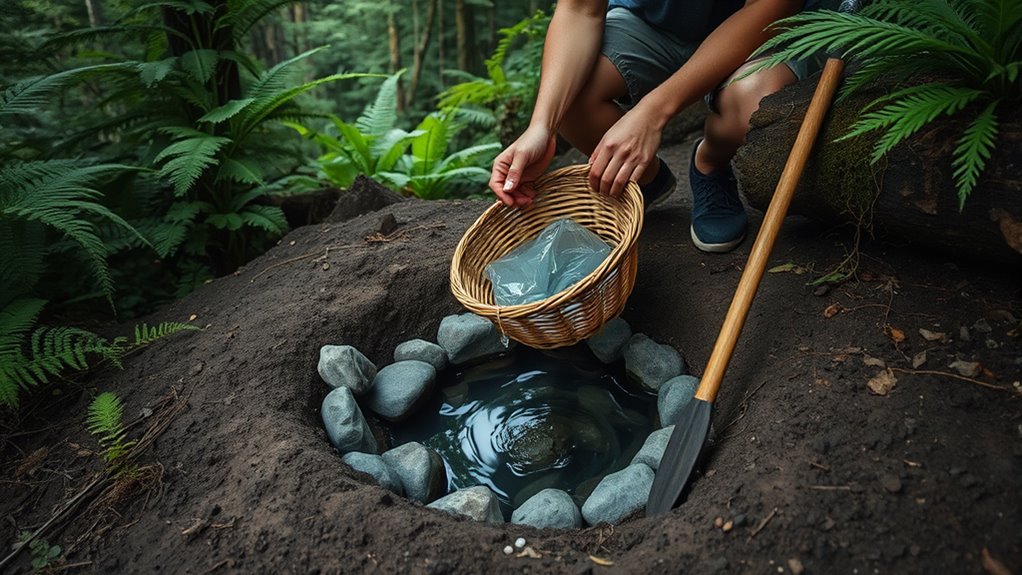
When natural surface water sources are scarce, digging and building water collection devices can provide essential hydration. One effective method for finding water is creating a solar still—dig a shallow hole, place a container at the bottom, then cover it with plastic. Weigh down the edges and create a central depression to direct condensation into your container. Using plastic is vital for sealing and maximizing water collection. You can also dig underground water stills by creating a bowl-shaped hole, lining it with rocks and organic material, then covering it with plastic to condense moisture. Remember to filter collected water through cloth, sand, or charcoal to remove debris and pathogens before drinking. Proper sealing and directing condensation increase your chances of gathering safe water in the wilderness. Additionally, understanding water sourcing techniques can help you identify hidden underground supplies more effectively. Developing water conservation skills is equally important to make your water supply last longer during prolonged wilderness survival situations. Practicing water purification methods ensures that even contaminated sources can be made safe for consumption. Incorporating alternative collection methods can further diversify your water gathering strategies, especially in varied environments.
Melting Snow and Ice Safely
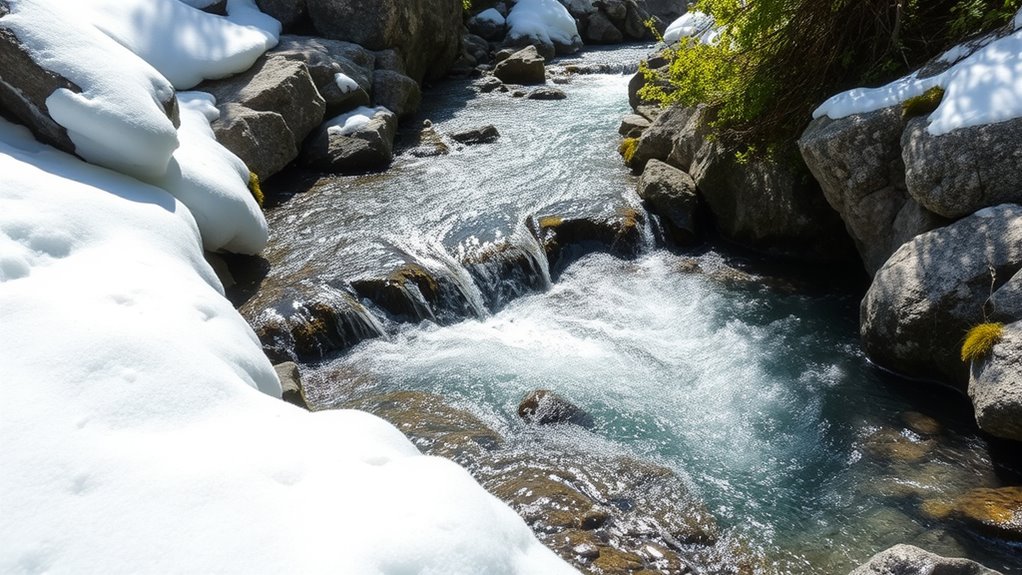
Have you ever wondered how to melt snow and ice safely in the wilderness? To turn ice and snow into drinkable water, avoid direct heat to prevent foul taste. Instead, melt snow gradually by placing it near a fire or using your body heat—stuff like a sock, cloth, or sealed bag filled with snow inside your clothing or sleeping gear works well. Collect snow during midday when the sun naturally heats it, especially on large rocks or open ground. Always purify water after melting by boiling or filtering to eliminate pathogens and contaminants. Remember, eating snow directly can lower your body temperature or cause dehydration. By melting snow safely and purifying the water, you’ll secure a crucial source of water in the wild when other options aren’t available.
Finding Water in Coastal and Desert Environments

Finding water in coastal and desert environments requires resourcefulness and careful testing. In coastal areas, dig a well about 100 feet from shore in a shallow hole lined with rocks and driftwood. This well can access fresh water filtered from rain and some seawater. To purify seawater further, heat rocks and drop them into the well to create steam, which you can collect on a cloth. Always taste a small amount to check for saltiness; move further from shore if it’s too salty. Avoid relying on seawater, sea ice, or urine, as they dehydrate you and cause health issues. In deserts, collect early morning condensation from metal surfaces or rocks using cloths or containers before the sun evaporates it.
Filtering and Purifying Wild Water Sources

Filtering and purifying wild water sources is vital to make them safe for drinking. Start by filtering the water through a cloth, coffee filter, or commercial filter to remove large particles. This step guarantees better purification and reduces contaminants. To purify, you can boil water for at least one minute (or three minutes at high elevations) to kill bacteria, viruses, and parasites. When boiling isn’t possible, chemical disinfectants like iodine or chlorine tablets are effective—just follow the instructions carefully. Solar disinfection (SODIS) is another option: fill transparent bottles with water and expose them to sunlight for six hours to inactivate pathogens. For quick sterilization, portable UV purifiers using ultraviolet light are also highly effective. Proper filtering and purification are essential for safe drinking water in the wilderness.
Using Solar Stills to Extract Drinkable Water

You can create a solar still by digging a hole, placing a container in the center, and covering it with a plastic sheet. As moisture condenses on the plastic, it drips into the container, providing drinkable water. Afterward, remember to filter and purify the collected water before consumption.
Digging and Covering Method
When you set up a solar still, start by digging a hole about two to three feet deep in moist sand or mud, making sure to avoid seawater. Place a clean container at the center to catch the distilled water. Cover the hole with a plastic sheet, sealing the edges with rocks or soil to trap evaporation. Tie a small weight or stone in the middle of the plastic to form a cone, guiding condensed water droplets toward your container. As the sun heats the environment, water vapor rises, condenses on the plastic, and drips into your container, providing safe drinking water.
- Dig in moist, non-seawater sand or mud for best results
- Use a plastic sheet as the cover to trap evaporation
- Create a cone to direct distilled water into your container
- Always purify the collected water before drinking
Collecting Condensed Water
Have you ever wondered how to turn ground moisture into drinkable water using the sun? You can do this with a simple solar still. Dig a hole about two to three feet deep in moist sand or mud and place a clean container at the center to collect condensed water. Cover the hole with a durable plastic sheet, sealing the edges with rocks or dirt to trap heat. As the sun heats the ground, evaporation occurs, and moisture rises. When it hits the plastic sheet, condensation forms on its surface, creating droplets that drip into your container. The plastic sheet’s shape encourages condensation to flow downward. You can then use a straw or tube to drink the collected water directly or transfer it to a safe vessel for hydration.
Filtering and Purifying Water
Did you know that solar stills not only collect water but also effectively filter out most contaminants? The distillation process purifies contaminated water, making it safe to drink. When evaporation occurs, impurities like bacteria, salts, and chemicals are left behind, leaving you with potable water. To enhance water treatment, you can add charcoal or other filtering materials to the collection container. Remember, boiling isn’t necessary since the distillation process naturally removes pathogens. Proper sealing of the plastic cover guarantees maximum condensation. For best results, position your solar still in direct sunlight and check for tears or holes. Using a solar still is an efficient way to filter and purify water in the wilderness, turning dirty water into safe, drinkable water.
Tips for Staying Hydrated in Challenging Conditions
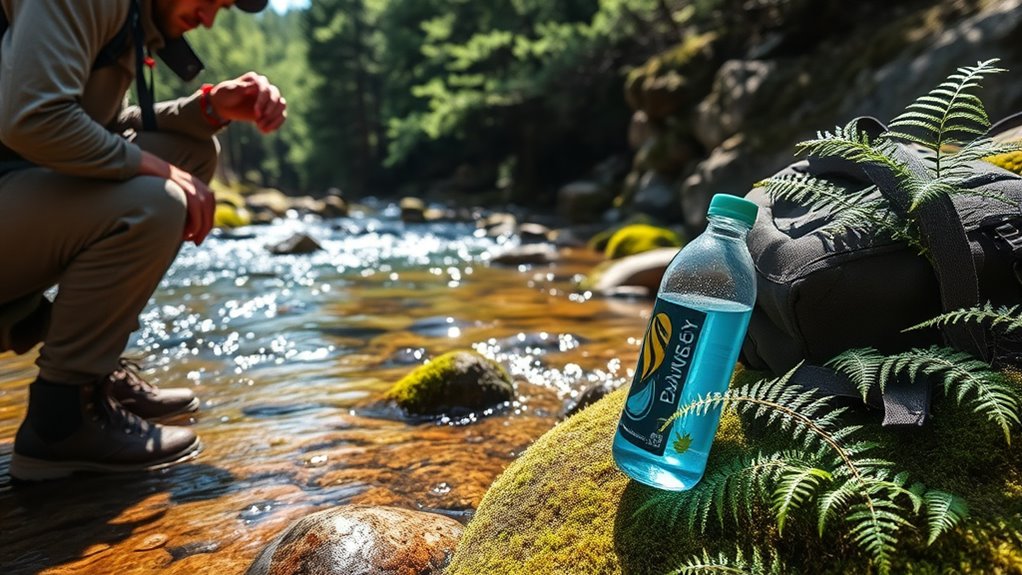
Staying hydrated in challenging conditions requires careful attention and smart strategies. First, locate reliable water sources by observing natural indicators like animal trails, bird flight paths, and dense vegetation, which often lead to streams or flowing water. Always purify water from natural sources before drinking to prevent illness. In extreme heat, drink small sips regularly instead of large gulps, helping you stay hydrated without overloading your system. Conserve water by limiting unnecessary activity and seeking new sources promptly before dehydration sets in. Carry enough water if possible, or know how to find and purify natural sources efficiently. Staying vigilant about your water intake and sources ensures you avoid dehydration and maintain strength during tough conditions.
Frequently Asked Questions
How to Find Fresh Water in Nature?
When you’re trying to find fresh water in nature, start by observing animal tracks that form “V” shapes, bird activity, and insect swarms, as they lead to water sources. Look for dense green vegetation, fog, or moisture on rocks, especially in low-lying areas or valleys. Follow sounds of running water, and watch for animal droppings or urine deposits, which often indicate nearby water. These signs help you locate a safe water source.
How to Find a Water Source in a Forest?
Imagine the forest whispers secrets to you; if you listen closely, you’ll find water. Follow the terrain downhill, especially along valleys and gullies, where water naturally flows. Look for lush green patches and listen for trickling sounds, tracing them upstream. Watch for animal trails, footprints, or drinking spots, and check for dew or moisture on plants and rocks. These clues will guide you to your essential water source.
How Do You Find Running Water in the Woods?
To find running water in the woods, listen carefully for the sounds of trickling or rushing streams. Look for greener vegetation, damp ground, or mineral deposits near creek beds. Follow animal trails, especially “V” shaped ones pointing downhill. Track upstream, as water flows downhill, and avoid moving downstream. By paying attention to these signs, you increase your chances of locating a reliable water source quickly.
How to Find Fresh Water in the Forest?
Imagine you’re lost in the forest, and need fresh water. You follow animal tracks and observe greener, denser foliage, which hints at nearby water. Listen for buzzing insects or running water sounds. Check natural depressions or mossy patches where water might collect. These environmental clues, combined with animal behavior like dawn drinking, guide you to a reliable freshwater source, ensuring your survival until help arrives.
Conclusion
Just like a skilled explorer finds hidden paths, you can uncover water in the wilderness by using these techniques. Remember when a hiker once followed animal tracks only to find a clear stream nearby—proving persistence pays off. Stay observant, adapt your methods, and trust your instincts. With each step, you turn the challenge of dehydration into an opportunity to thrive, transforming the wilderness into your own survival landscape.







